Report: UPS Staff Recruitment, Leadership Styles and Teamwork Analysis
VerifiedAdded on 2020/06/05
|15
|4132
|60
Report
AI Summary
This report provides a comprehensive analysis of staff recruitment, leadership, and motivation strategies within the context of the United Parcel Service (UPS). It begins by outlining the documentation required for recruiting new staff, emphasizing the role of the HR manager and the importance of legal, regulatory, and ethical considerations in the selection process. The report then delves into the essential skills and attributes of effective leadership, differentiating between leadership and management, and exploring various leadership styles applicable to different situations. Furthermore, it examines different methods for motivating staff to achieve organizational objectives, followed by an assessment of teamwork effectiveness. The report also addresses planning, monitoring, and evaluating assessment processes to enhance individual needs within the organization, with a focus on the contributions of an HR Manager to the overall selection process. The report highlights the importance of effective communication, commitment, decisiveness, and team-building skills for leaders, and it concludes by emphasizing the significance of ethical, moral, legal, and operational standards in the recruitment and selection process.
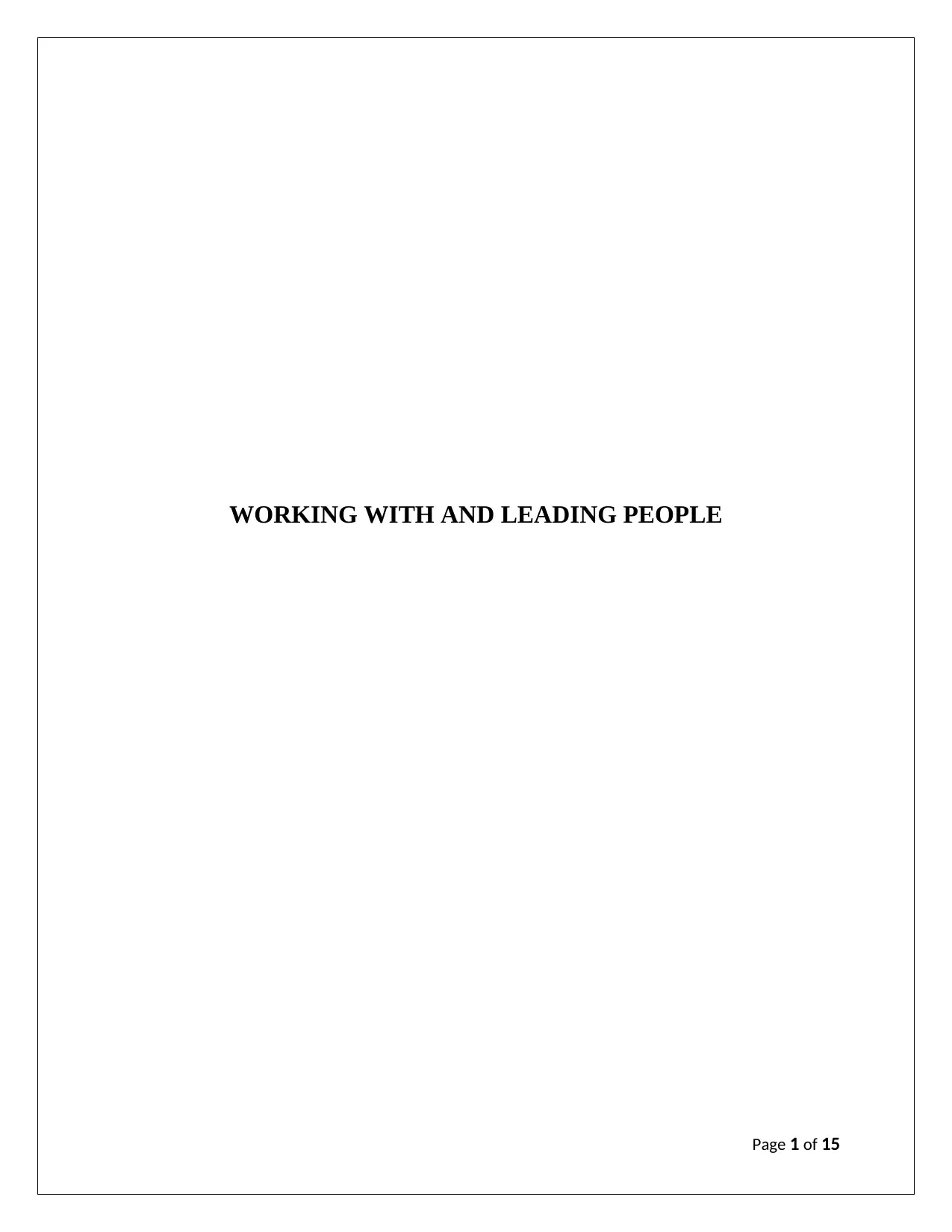
WORKING WITH AND LEADING PEOPLE
Page 1 of 15
Page 1 of 15
Paraphrase This Document
Need a fresh take? Get an instant paraphrase of this document with our AI Paraphraser
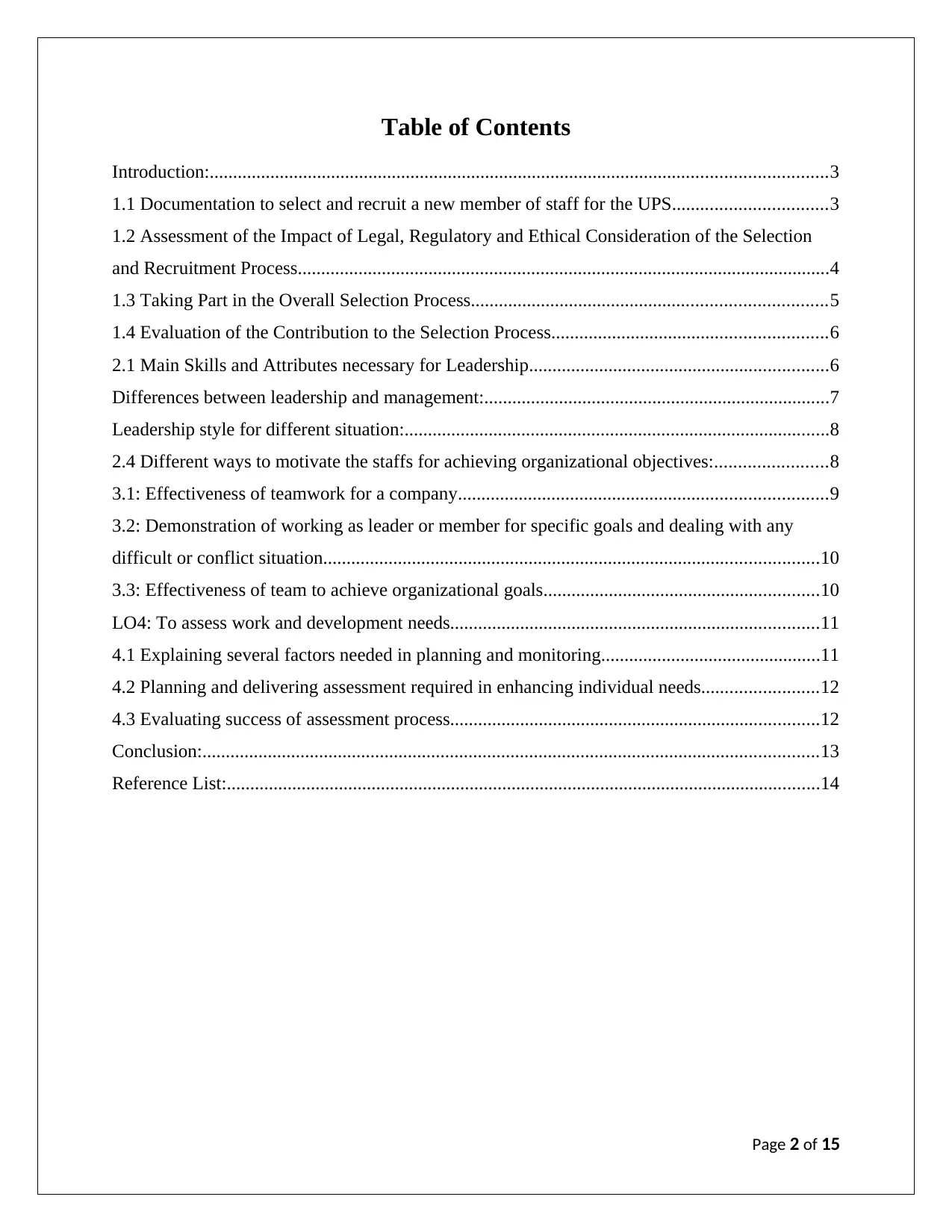
Table of Contents
Introduction:....................................................................................................................................3
1.1 Documentation to select and recruit a new member of staff for the UPS.................................3
1.2 Assessment of the Impact of Legal, Regulatory and Ethical Consideration of the Selection
and Recruitment Process..................................................................................................................4
1.3 Taking Part in the Overall Selection Process............................................................................5
1.4 Evaluation of the Contribution to the Selection Process...........................................................6
2.1 Main Skills and Attributes necessary for Leadership................................................................6
Differences between leadership and management:..........................................................................7
Leadership style for different situation:...........................................................................................8
2.4 Different ways to motivate the staffs for achieving organizational objectives:........................8
3.1: Effectiveness of teamwork for a company...............................................................................9
3.2: Demonstration of working as leader or member for specific goals and dealing with any
difficult or conflict situation..........................................................................................................10
3.3: Effectiveness of team to achieve organizational goals...........................................................10
LO4: To assess work and development needs...............................................................................11
4.1 Explaining several factors needed in planning and monitoring...............................................11
4.2 Planning and delivering assessment required in enhancing individual needs.........................12
4.3 Evaluating success of assessment process...............................................................................12
Conclusion:....................................................................................................................................13
Reference List:...............................................................................................................................14
Page 2 of 15
Introduction:....................................................................................................................................3
1.1 Documentation to select and recruit a new member of staff for the UPS.................................3
1.2 Assessment of the Impact of Legal, Regulatory and Ethical Consideration of the Selection
and Recruitment Process..................................................................................................................4
1.3 Taking Part in the Overall Selection Process............................................................................5
1.4 Evaluation of the Contribution to the Selection Process...........................................................6
2.1 Main Skills and Attributes necessary for Leadership................................................................6
Differences between leadership and management:..........................................................................7
Leadership style for different situation:...........................................................................................8
2.4 Different ways to motivate the staffs for achieving organizational objectives:........................8
3.1: Effectiveness of teamwork for a company...............................................................................9
3.2: Demonstration of working as leader or member for specific goals and dealing with any
difficult or conflict situation..........................................................................................................10
3.3: Effectiveness of team to achieve organizational goals...........................................................10
LO4: To assess work and development needs...............................................................................11
4.1 Explaining several factors needed in planning and monitoring...............................................11
4.2 Planning and delivering assessment required in enhancing individual needs.........................12
4.3 Evaluating success of assessment process...............................................................................12
Conclusion:....................................................................................................................................13
Reference List:...............................................................................................................................14
Page 2 of 15

Introduction:
This report presents a solution for the United Kingdom based company, united parcel service.
This company is doing their functions in parcel service. This company is now facing the
leadership, managements, and administrative problems. In order to solve that a acute planning
has presented below which demonstrates the path of overcome from this crisis situation.
1.1 Documentation to select and recruit a new member of staff for the UPS
In any organization, staffs are the main pillar to carry out the functional process successfully.
The successful recruiting of a potential staff in the UPS Company can be possible by a strong
and skillful HR manger. The Human resource departments have to outline a specific structure of
recruitment. The human resource department is responsible to add the quality resources in the
overall system in the organizational agendas (Kurtz and William, 2017). A concrete and well
prepared documentation helps any company to recruit a new member of staff in the existing
employee force. The human resource department is responsible to prepare a document to select
and recruit a new member of staff. The main agendas in this part are-
As a HR manger of the UPS the below mentioned task need to be done successfully:
Search different kinds of job portals to find out the appropriate and potential candidate
Contact with those aspirants who are matched the criterion of the assigned job
requirements
Contact with the desired candidate with job specification. This process can be done by
sending mails and sms or by doing calls
Fix appointment for the interview with the necessary details
During pre interview critically asses the professional profile of the candidate to know
about the positive skills of the screening candidate
On the day of interview co- ordinate with the interview and to the employer
Page 3 of 15
This report presents a solution for the United Kingdom based company, united parcel service.
This company is doing their functions in parcel service. This company is now facing the
leadership, managements, and administrative problems. In order to solve that a acute planning
has presented below which demonstrates the path of overcome from this crisis situation.
1.1 Documentation to select and recruit a new member of staff for the UPS
In any organization, staffs are the main pillar to carry out the functional process successfully.
The successful recruiting of a potential staff in the UPS Company can be possible by a strong
and skillful HR manger. The Human resource departments have to outline a specific structure of
recruitment. The human resource department is responsible to add the quality resources in the
overall system in the organizational agendas (Kurtz and William, 2017). A concrete and well
prepared documentation helps any company to recruit a new member of staff in the existing
employee force. The human resource department is responsible to prepare a document to select
and recruit a new member of staff. The main agendas in this part are-
As a HR manger of the UPS the below mentioned task need to be done successfully:
Search different kinds of job portals to find out the appropriate and potential candidate
Contact with those aspirants who are matched the criterion of the assigned job
requirements
Contact with the desired candidate with job specification. This process can be done by
sending mails and sms or by doing calls
Fix appointment for the interview with the necessary details
During pre interview critically asses the professional profile of the candidate to know
about the positive skills of the screening candidate
On the day of interview co- ordinate with the interview and to the employer
Page 3 of 15
⊘ This is a preview!⊘
Do you want full access?
Subscribe today to unlock all pages.

Trusted by 1+ million students worldwide
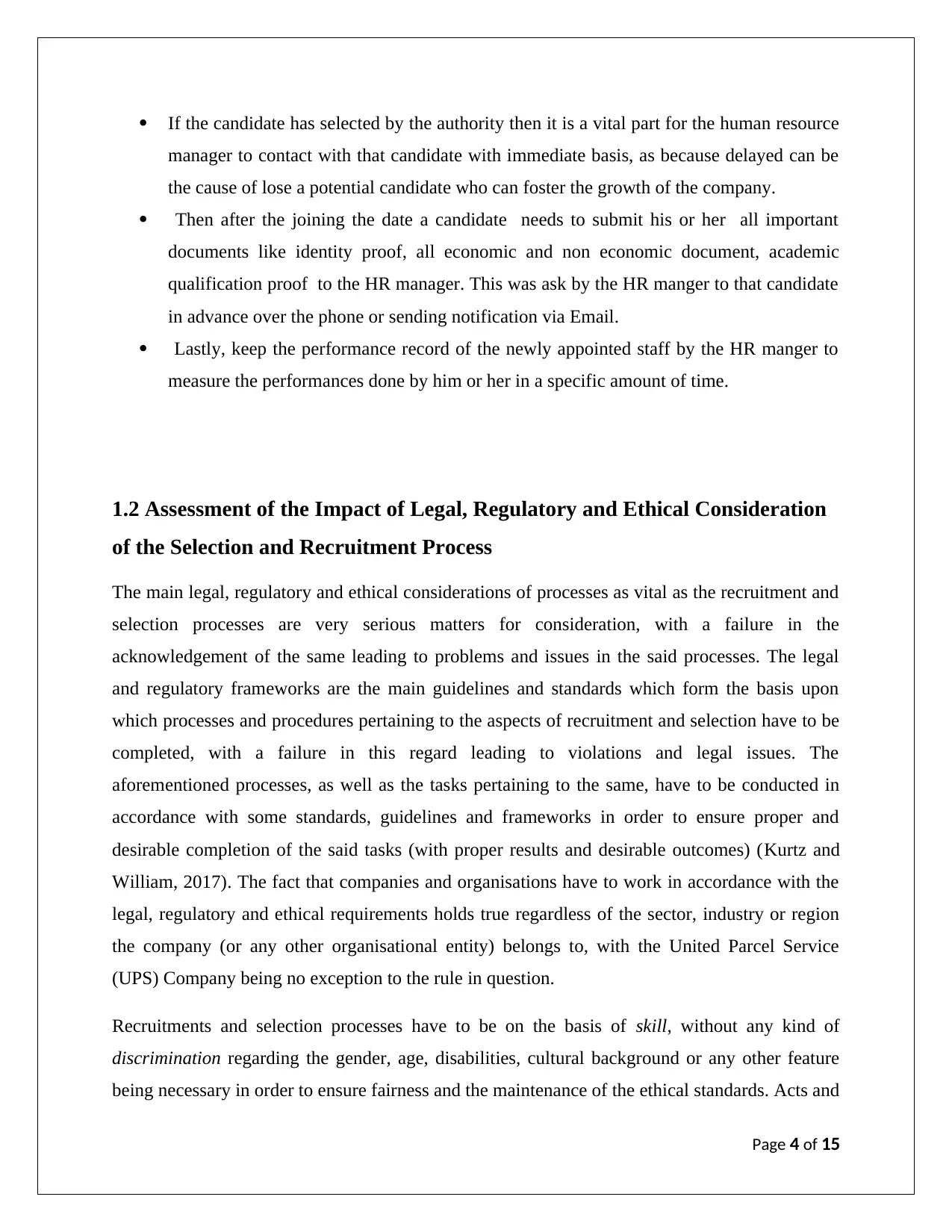
If the candidate has selected by the authority then it is a vital part for the human resource
manager to contact with that candidate with immediate basis, as because delayed can be
the cause of lose a potential candidate who can foster the growth of the company.
Then after the joining the date a candidate needs to submit his or her all important
documents like identity proof, all economic and non economic document, academic
qualification proof to the HR manager. This was ask by the HR manger to that candidate
in advance over the phone or sending notification via Email.
Lastly, keep the performance record of the newly appointed staff by the HR manger to
measure the performances done by him or her in a specific amount of time.
1.2 Assessment of the Impact of Legal, Regulatory and Ethical Consideration
of the Selection and Recruitment Process
The main legal, regulatory and ethical considerations of processes as vital as the recruitment and
selection processes are very serious matters for consideration, with a failure in the
acknowledgement of the same leading to problems and issues in the said processes. The legal
and regulatory frameworks are the main guidelines and standards which form the basis upon
which processes and procedures pertaining to the aspects of recruitment and selection have to be
completed, with a failure in this regard leading to violations and legal issues. The
aforementioned processes, as well as the tasks pertaining to the same, have to be conducted in
accordance with some standards, guidelines and frameworks in order to ensure proper and
desirable completion of the said tasks (with proper results and desirable outcomes) (Kurtz and
William, 2017). The fact that companies and organisations have to work in accordance with the
legal, regulatory and ethical requirements holds true regardless of the sector, industry or region
the company (or any other organisational entity) belongs to, with the United Parcel Service
(UPS) Company being no exception to the rule in question.
Recruitments and selection processes have to be on the basis of skill, without any kind of
discrimination regarding the gender, age, disabilities, cultural background or any other feature
being necessary in order to ensure fairness and the maintenance of the ethical standards. Acts and
Page 4 of 15
manager to contact with that candidate with immediate basis, as because delayed can be
the cause of lose a potential candidate who can foster the growth of the company.
Then after the joining the date a candidate needs to submit his or her all important
documents like identity proof, all economic and non economic document, academic
qualification proof to the HR manager. This was ask by the HR manger to that candidate
in advance over the phone or sending notification via Email.
Lastly, keep the performance record of the newly appointed staff by the HR manger to
measure the performances done by him or her in a specific amount of time.
1.2 Assessment of the Impact of Legal, Regulatory and Ethical Consideration
of the Selection and Recruitment Process
The main legal, regulatory and ethical considerations of processes as vital as the recruitment and
selection processes are very serious matters for consideration, with a failure in the
acknowledgement of the same leading to problems and issues in the said processes. The legal
and regulatory frameworks are the main guidelines and standards which form the basis upon
which processes and procedures pertaining to the aspects of recruitment and selection have to be
completed, with a failure in this regard leading to violations and legal issues. The
aforementioned processes, as well as the tasks pertaining to the same, have to be conducted in
accordance with some standards, guidelines and frameworks in order to ensure proper and
desirable completion of the said tasks (with proper results and desirable outcomes) (Kurtz and
William, 2017). The fact that companies and organisations have to work in accordance with the
legal, regulatory and ethical requirements holds true regardless of the sector, industry or region
the company (or any other organisational entity) belongs to, with the United Parcel Service
(UPS) Company being no exception to the rule in question.
Recruitments and selection processes have to be on the basis of skill, without any kind of
discrimination regarding the gender, age, disabilities, cultural background or any other feature
being necessary in order to ensure fairness and the maintenance of the ethical standards. Acts and
Page 4 of 15
Paraphrase This Document
Need a fresh take? Get an instant paraphrase of this document with our AI Paraphraser
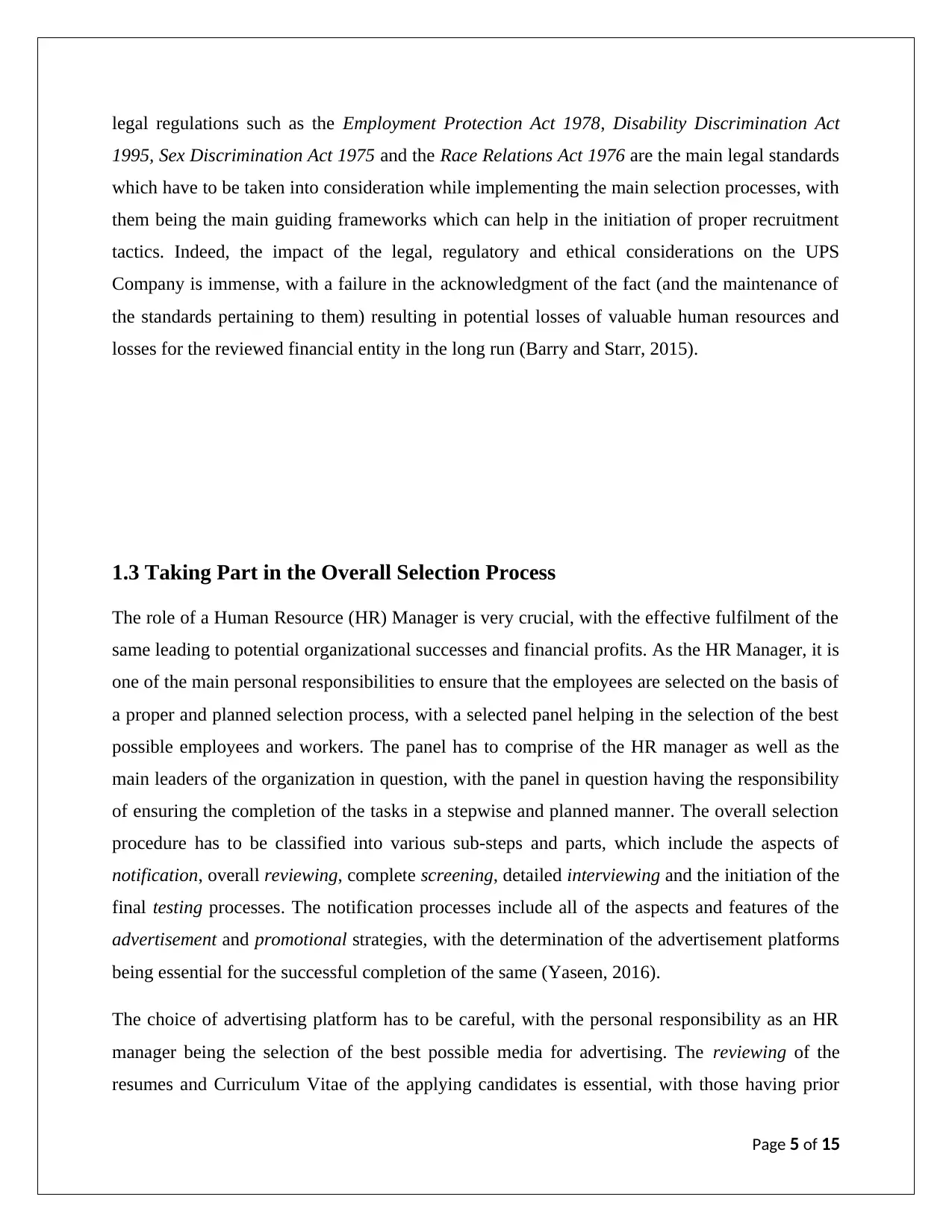
legal regulations such as the Employment Protection Act 1978, Disability Discrimination Act
1995, Sex Discrimination Act 1975 and the Race Relations Act 1976 are the main legal standards
which have to be taken into consideration while implementing the main selection processes, with
them being the main guiding frameworks which can help in the initiation of proper recruitment
tactics. Indeed, the impact of the legal, regulatory and ethical considerations on the UPS
Company is immense, with a failure in the acknowledgment of the fact (and the maintenance of
the standards pertaining to them) resulting in potential losses of valuable human resources and
losses for the reviewed financial entity in the long run (Barry and Starr, 2015).
1.3 Taking Part in the Overall Selection Process
The role of a Human Resource (HR) Manager is very crucial, with the effective fulfilment of the
same leading to potential organizational successes and financial profits. As the HR Manager, it is
one of the main personal responsibilities to ensure that the employees are selected on the basis of
a proper and planned selection process, with a selected panel helping in the selection of the best
possible employees and workers. The panel has to comprise of the HR manager as well as the
main leaders of the organization in question, with the panel in question having the responsibility
of ensuring the completion of the tasks in a stepwise and planned manner. The overall selection
procedure has to be classified into various sub-steps and parts, which include the aspects of
notification, overall reviewing, complete screening, detailed interviewing and the initiation of the
final testing processes. The notification processes include all of the aspects and features of the
advertisement and promotional strategies, with the determination of the advertisement platforms
being essential for the successful completion of the same (Yaseen, 2016).
The choice of advertising platform has to be careful, with the personal responsibility as an HR
manager being the selection of the best possible media for advertising. The reviewing of the
resumes and Curriculum Vitae of the applying candidates is essential, with those having prior
Page 5 of 15
1995, Sex Discrimination Act 1975 and the Race Relations Act 1976 are the main legal standards
which have to be taken into consideration while implementing the main selection processes, with
them being the main guiding frameworks which can help in the initiation of proper recruitment
tactics. Indeed, the impact of the legal, regulatory and ethical considerations on the UPS
Company is immense, with a failure in the acknowledgment of the fact (and the maintenance of
the standards pertaining to them) resulting in potential losses of valuable human resources and
losses for the reviewed financial entity in the long run (Barry and Starr, 2015).
1.3 Taking Part in the Overall Selection Process
The role of a Human Resource (HR) Manager is very crucial, with the effective fulfilment of the
same leading to potential organizational successes and financial profits. As the HR Manager, it is
one of the main personal responsibilities to ensure that the employees are selected on the basis of
a proper and planned selection process, with a selected panel helping in the selection of the best
possible employees and workers. The panel has to comprise of the HR manager as well as the
main leaders of the organization in question, with the panel in question having the responsibility
of ensuring the completion of the tasks in a stepwise and planned manner. The overall selection
procedure has to be classified into various sub-steps and parts, which include the aspects of
notification, overall reviewing, complete screening, detailed interviewing and the initiation of the
final testing processes. The notification processes include all of the aspects and features of the
advertisement and promotional strategies, with the determination of the advertisement platforms
being essential for the successful completion of the same (Yaseen, 2016).
The choice of advertising platform has to be careful, with the personal responsibility as an HR
manager being the selection of the best possible media for advertising. The reviewing of the
resumes and Curriculum Vitae of the applying candidates is essential, with those having prior
Page 5 of 15
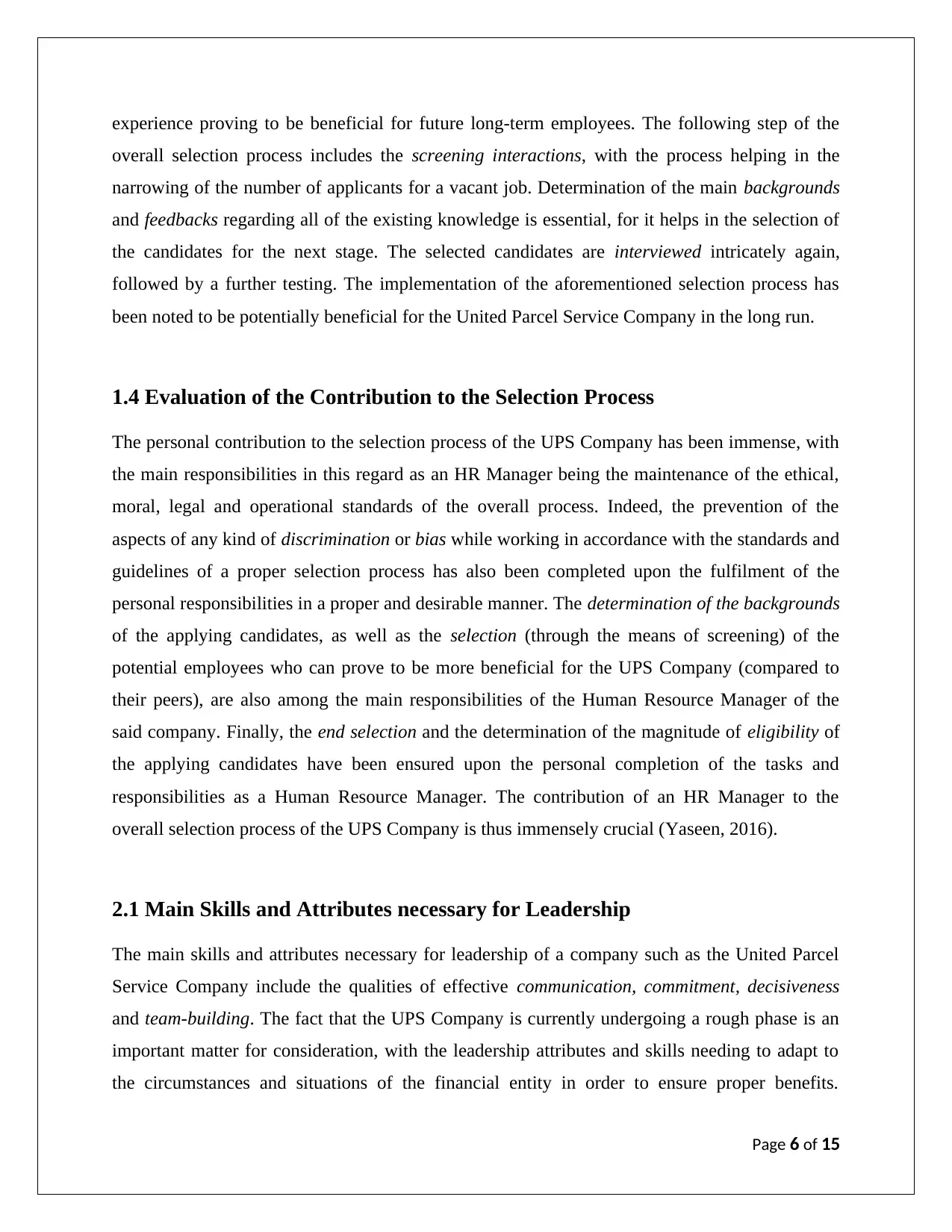
experience proving to be beneficial for future long-term employees. The following step of the
overall selection process includes the screening interactions, with the process helping in the
narrowing of the number of applicants for a vacant job. Determination of the main backgrounds
and feedbacks regarding all of the existing knowledge is essential, for it helps in the selection of
the candidates for the next stage. The selected candidates are interviewed intricately again,
followed by a further testing. The implementation of the aforementioned selection process has
been noted to be potentially beneficial for the United Parcel Service Company in the long run.
1.4 Evaluation of the Contribution to the Selection Process
The personal contribution to the selection process of the UPS Company has been immense, with
the main responsibilities in this regard as an HR Manager being the maintenance of the ethical,
moral, legal and operational standards of the overall process. Indeed, the prevention of the
aspects of any kind of discrimination or bias while working in accordance with the standards and
guidelines of a proper selection process has also been completed upon the fulfilment of the
personal responsibilities in a proper and desirable manner. The determination of the backgrounds
of the applying candidates, as well as the selection (through the means of screening) of the
potential employees who can prove to be more beneficial for the UPS Company (compared to
their peers), are also among the main responsibilities of the Human Resource Manager of the
said company. Finally, the end selection and the determination of the magnitude of eligibility of
the applying candidates have been ensured upon the personal completion of the tasks and
responsibilities as a Human Resource Manager. The contribution of an HR Manager to the
overall selection process of the UPS Company is thus immensely crucial (Yaseen, 2016).
2.1 Main Skills and Attributes necessary for Leadership
The main skills and attributes necessary for leadership of a company such as the United Parcel
Service Company include the qualities of effective communication, commitment, decisiveness
and team-building. The fact that the UPS Company is currently undergoing a rough phase is an
important matter for consideration, with the leadership attributes and skills needing to adapt to
the circumstances and situations of the financial entity in order to ensure proper benefits.
Page 6 of 15
overall selection process includes the screening interactions, with the process helping in the
narrowing of the number of applicants for a vacant job. Determination of the main backgrounds
and feedbacks regarding all of the existing knowledge is essential, for it helps in the selection of
the candidates for the next stage. The selected candidates are interviewed intricately again,
followed by a further testing. The implementation of the aforementioned selection process has
been noted to be potentially beneficial for the United Parcel Service Company in the long run.
1.4 Evaluation of the Contribution to the Selection Process
The personal contribution to the selection process of the UPS Company has been immense, with
the main responsibilities in this regard as an HR Manager being the maintenance of the ethical,
moral, legal and operational standards of the overall process. Indeed, the prevention of the
aspects of any kind of discrimination or bias while working in accordance with the standards and
guidelines of a proper selection process has also been completed upon the fulfilment of the
personal responsibilities in a proper and desirable manner. The determination of the backgrounds
of the applying candidates, as well as the selection (through the means of screening) of the
potential employees who can prove to be more beneficial for the UPS Company (compared to
their peers), are also among the main responsibilities of the Human Resource Manager of the
said company. Finally, the end selection and the determination of the magnitude of eligibility of
the applying candidates have been ensured upon the personal completion of the tasks and
responsibilities as a Human Resource Manager. The contribution of an HR Manager to the
overall selection process of the UPS Company is thus immensely crucial (Yaseen, 2016).
2.1 Main Skills and Attributes necessary for Leadership
The main skills and attributes necessary for leadership of a company such as the United Parcel
Service Company include the qualities of effective communication, commitment, decisiveness
and team-building. The fact that the UPS Company is currently undergoing a rough phase is an
important matter for consideration, with the leadership attributes and skills needing to adapt to
the circumstances and situations of the financial entity in order to ensure proper benefits.
Page 6 of 15
⊘ This is a preview!⊘
Do you want full access?
Subscribe today to unlock all pages.

Trusted by 1+ million students worldwide
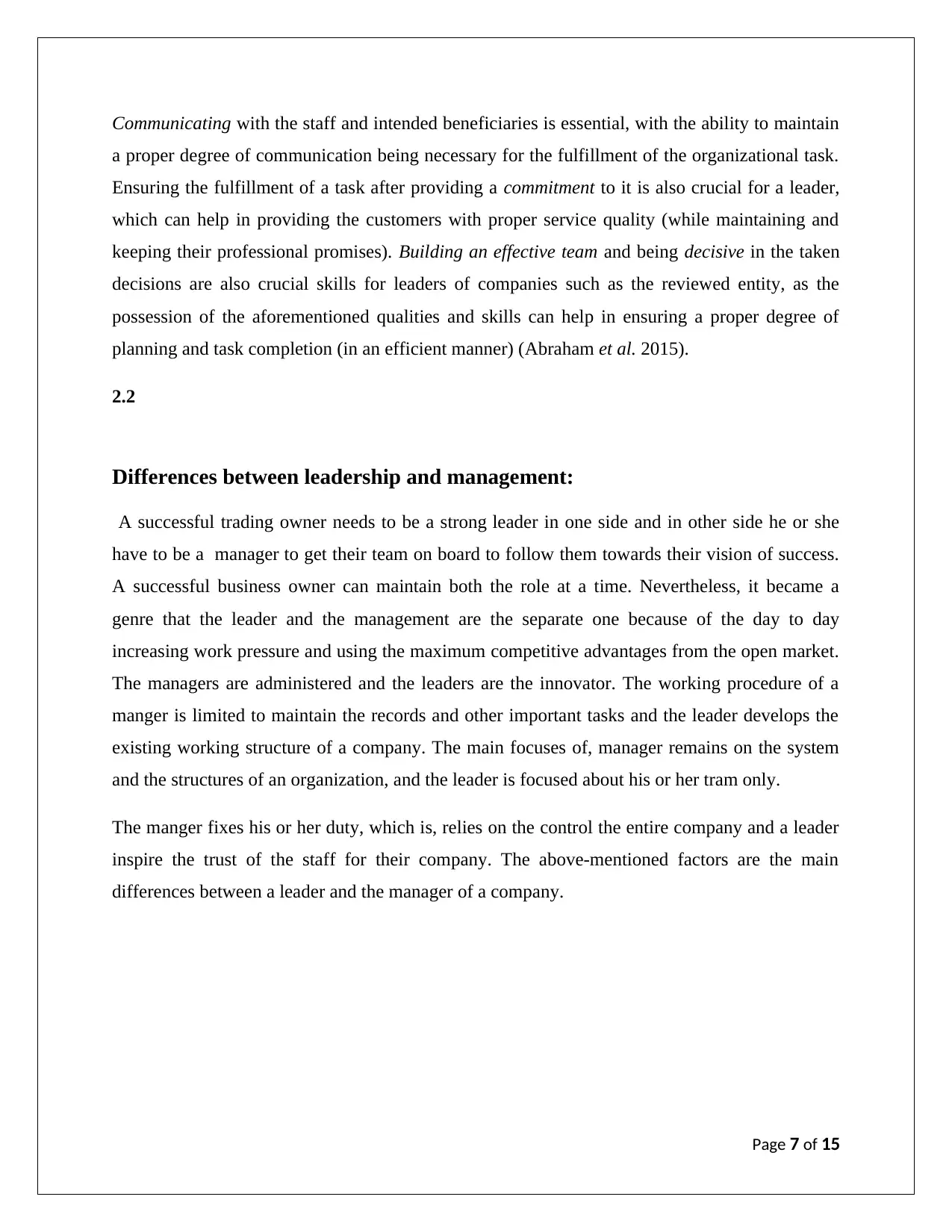
Communicating with the staff and intended beneficiaries is essential, with the ability to maintain
a proper degree of communication being necessary for the fulfillment of the organizational task.
Ensuring the fulfillment of a task after providing a commitment to it is also crucial for a leader,
which can help in providing the customers with proper service quality (while maintaining and
keeping their professional promises). Building an effective team and being decisive in the taken
decisions are also crucial skills for leaders of companies such as the reviewed entity, as the
possession of the aforementioned qualities and skills can help in ensuring a proper degree of
planning and task completion (in an efficient manner) (Abraham et al. 2015).
2.2
Differences between leadership and management:
A successful trading owner needs to be a strong leader in one side and in other side he or she
have to be a manager to get their team on board to follow them towards their vision of success.
A successful business owner can maintain both the role at a time. Nevertheless, it became a
genre that the leader and the management are the separate one because of the day to day
increasing work pressure and using the maximum competitive advantages from the open market.
The managers are administered and the leaders are the innovator. The working procedure of a
manger is limited to maintain the records and other important tasks and the leader develops the
existing working structure of a company. The main focuses of, manager remains on the system
and the structures of an organization, and the leader is focused about his or her tram only.
The manger fixes his or her duty, which is, relies on the control the entire company and a leader
inspire the trust of the staff for their company. The above-mentioned factors are the main
differences between a leader and the manager of a company.
Page 7 of 15
a proper degree of communication being necessary for the fulfillment of the organizational task.
Ensuring the fulfillment of a task after providing a commitment to it is also crucial for a leader,
which can help in providing the customers with proper service quality (while maintaining and
keeping their professional promises). Building an effective team and being decisive in the taken
decisions are also crucial skills for leaders of companies such as the reviewed entity, as the
possession of the aforementioned qualities and skills can help in ensuring a proper degree of
planning and task completion (in an efficient manner) (Abraham et al. 2015).
2.2
Differences between leadership and management:
A successful trading owner needs to be a strong leader in one side and in other side he or she
have to be a manager to get their team on board to follow them towards their vision of success.
A successful business owner can maintain both the role at a time. Nevertheless, it became a
genre that the leader and the management are the separate one because of the day to day
increasing work pressure and using the maximum competitive advantages from the open market.
The managers are administered and the leaders are the innovator. The working procedure of a
manger is limited to maintain the records and other important tasks and the leader develops the
existing working structure of a company. The main focuses of, manager remains on the system
and the structures of an organization, and the leader is focused about his or her tram only.
The manger fixes his or her duty, which is, relies on the control the entire company and a leader
inspire the trust of the staff for their company. The above-mentioned factors are the main
differences between a leader and the manager of a company.
Page 7 of 15
Paraphrase This Document
Need a fresh take? Get an instant paraphrase of this document with our AI Paraphraser
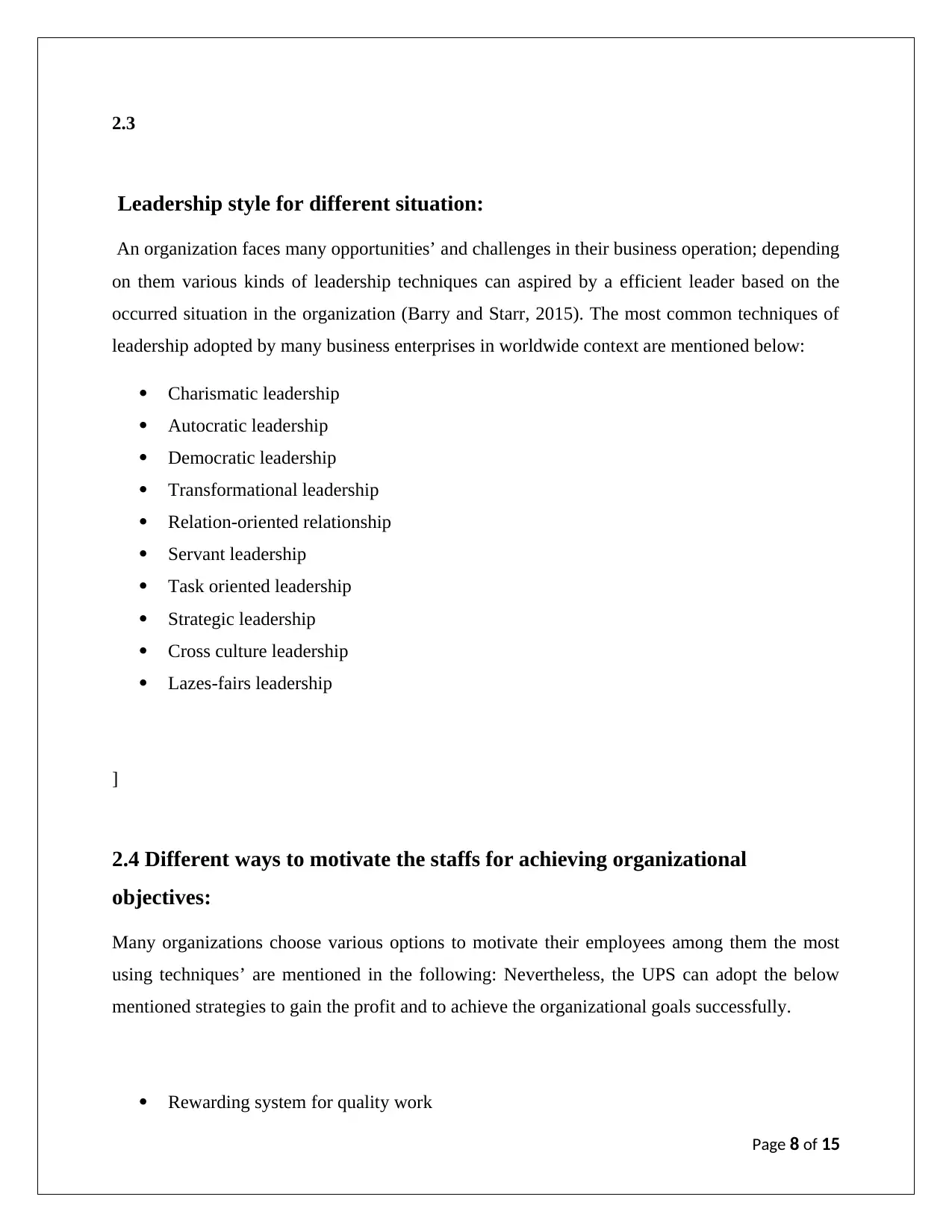
2.3
Leadership style for different situation:
An organization faces many opportunities’ and challenges in their business operation; depending
on them various kinds of leadership techniques can aspired by a efficient leader based on the
occurred situation in the organization (Barry and Starr, 2015). The most common techniques of
leadership adopted by many business enterprises in worldwide context are mentioned below:
Charismatic leadership
Autocratic leadership
Democratic leadership
Transformational leadership
Relation-oriented relationship
Servant leadership
Task oriented leadership
Strategic leadership
Cross culture leadership
Lazes-fairs leadership
]
2.4 Different ways to motivate the staffs for achieving organizational
objectives:
Many organizations choose various options to motivate their employees among them the most
using techniques’ are mentioned in the following: Nevertheless, the UPS can adopt the below
mentioned strategies to gain the profit and to achieve the organizational goals successfully.
Rewarding system for quality work
Page 8 of 15
Leadership style for different situation:
An organization faces many opportunities’ and challenges in their business operation; depending
on them various kinds of leadership techniques can aspired by a efficient leader based on the
occurred situation in the organization (Barry and Starr, 2015). The most common techniques of
leadership adopted by many business enterprises in worldwide context are mentioned below:
Charismatic leadership
Autocratic leadership
Democratic leadership
Transformational leadership
Relation-oriented relationship
Servant leadership
Task oriented leadership
Strategic leadership
Cross culture leadership
Lazes-fairs leadership
]
2.4 Different ways to motivate the staffs for achieving organizational
objectives:
Many organizations choose various options to motivate their employees among them the most
using techniques’ are mentioned in the following: Nevertheless, the UPS can adopt the below
mentioned strategies to gain the profit and to achieve the organizational goals successfully.
Rewarding system for quality work
Page 8 of 15
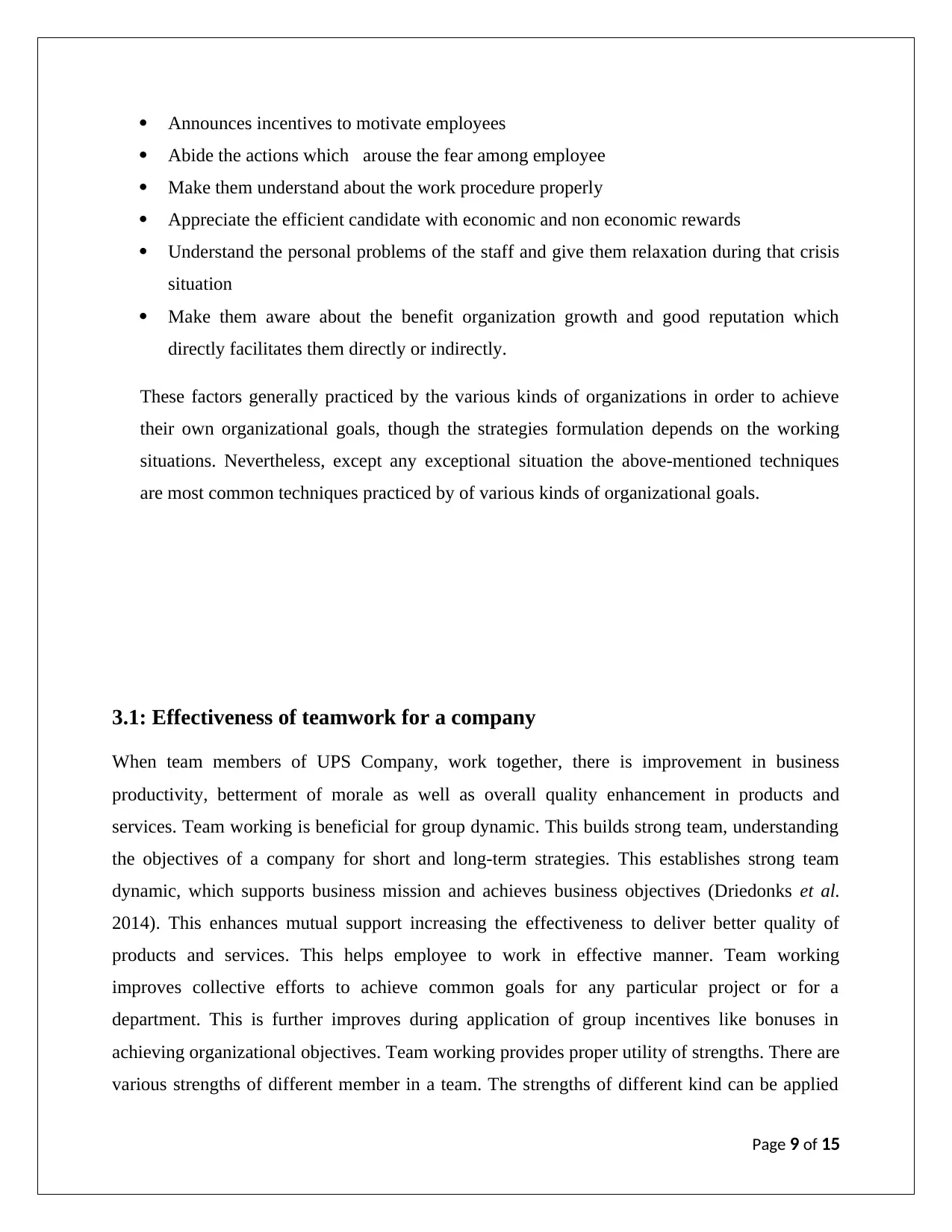
Announces incentives to motivate employees
Abide the actions which arouse the fear among employee
Make them understand about the work procedure properly
Appreciate the efficient candidate with economic and non economic rewards
Understand the personal problems of the staff and give them relaxation during that crisis
situation
Make them aware about the benefit organization growth and good reputation which
directly facilitates them directly or indirectly.
These factors generally practiced by the various kinds of organizations in order to achieve
their own organizational goals, though the strategies formulation depends on the working
situations. Nevertheless, except any exceptional situation the above-mentioned techniques
are most common techniques practiced by of various kinds of organizational goals.
3.1: Effectiveness of teamwork for a company
When team members of UPS Company, work together, there is improvement in business
productivity, betterment of morale as well as overall quality enhancement in products and
services. Team working is beneficial for group dynamic. This builds strong team, understanding
the objectives of a company for short and long-term strategies. This establishes strong team
dynamic, which supports business mission and achieves business objectives (Driedonks et al.
2014). This enhances mutual support increasing the effectiveness to deliver better quality of
products and services. This helps employee to work in effective manner. Team working
improves collective efforts to achieve common goals for any particular project or for a
department. This is further improves during application of group incentives like bonuses in
achieving organizational objectives. Team working provides proper utility of strengths. There are
various strengths of different member in a team. The strengths of different kind can be applied
Page 9 of 15
Abide the actions which arouse the fear among employee
Make them understand about the work procedure properly
Appreciate the efficient candidate with economic and non economic rewards
Understand the personal problems of the staff and give them relaxation during that crisis
situation
Make them aware about the benefit organization growth and good reputation which
directly facilitates them directly or indirectly.
These factors generally practiced by the various kinds of organizations in order to achieve
their own organizational goals, though the strategies formulation depends on the working
situations. Nevertheless, except any exceptional situation the above-mentioned techniques
are most common techniques practiced by of various kinds of organizational goals.
3.1: Effectiveness of teamwork for a company
When team members of UPS Company, work together, there is improvement in business
productivity, betterment of morale as well as overall quality enhancement in products and
services. Team working is beneficial for group dynamic. This builds strong team, understanding
the objectives of a company for short and long-term strategies. This establishes strong team
dynamic, which supports business mission and achieves business objectives (Driedonks et al.
2014). This enhances mutual support increasing the effectiveness to deliver better quality of
products and services. This helps employee to work in effective manner. Team working
improves collective efforts to achieve common goals for any particular project or for a
department. This is further improves during application of group incentives like bonuses in
achieving organizational objectives. Team working provides proper utility of strengths. There are
various strengths of different member in a team. The strengths of different kind can be applied
Page 9 of 15
⊘ This is a preview!⊘
Do you want full access?
Subscribe today to unlock all pages.

Trusted by 1+ million students worldwide
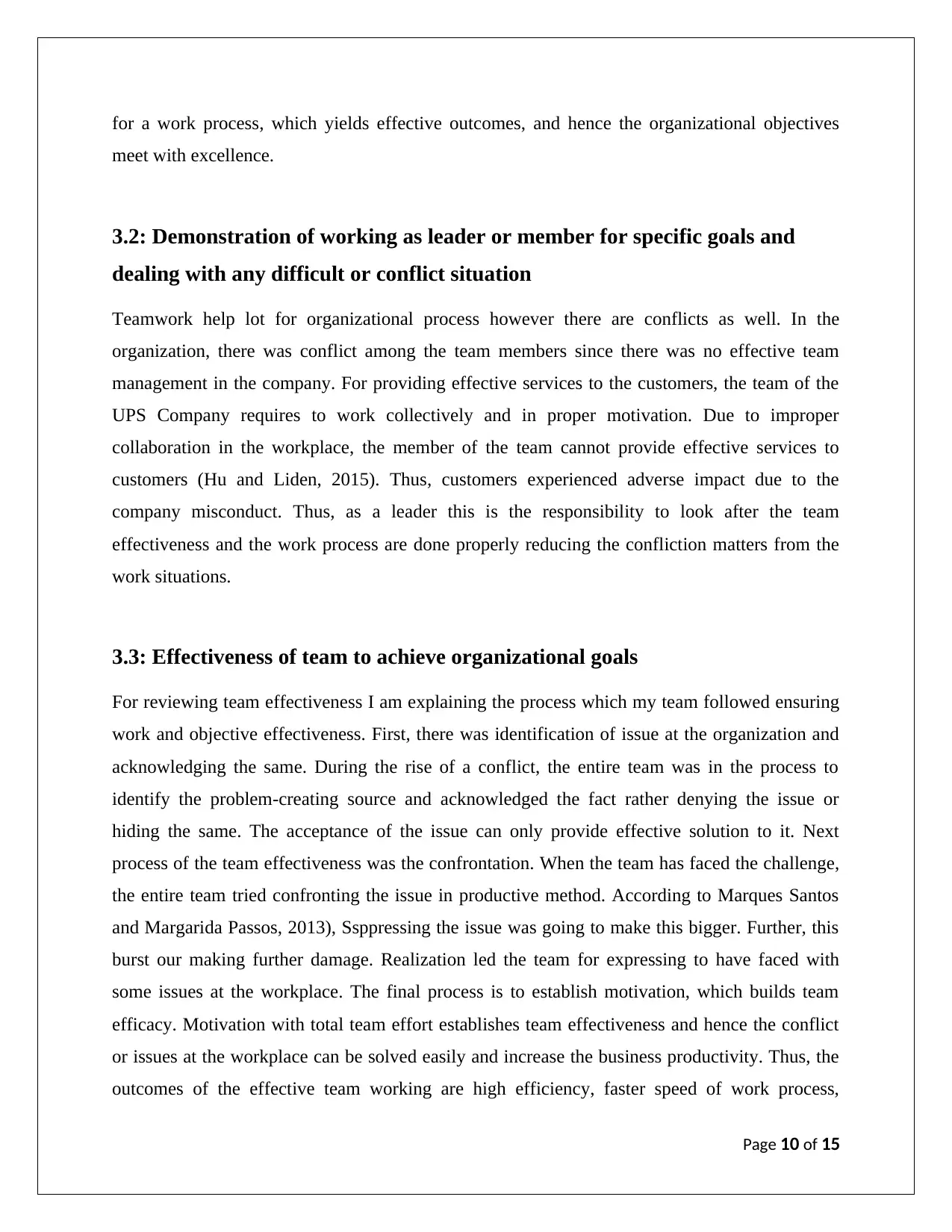
for a work process, which yields effective outcomes, and hence the organizational objectives
meet with excellence.
3.2: Demonstration of working as leader or member for specific goals and
dealing with any difficult or conflict situation
Teamwork help lot for organizational process however there are conflicts as well. In the
organization, there was conflict among the team members since there was no effective team
management in the company. For providing effective services to the customers, the team of the
UPS Company requires to work collectively and in proper motivation. Due to improper
collaboration in the workplace, the member of the team cannot provide effective services to
customers (Hu and Liden, 2015). Thus, customers experienced adverse impact due to the
company misconduct. Thus, as a leader this is the responsibility to look after the team
effectiveness and the work process are done properly reducing the confliction matters from the
work situations.
3.3: Effectiveness of team to achieve organizational goals
For reviewing team effectiveness I am explaining the process which my team followed ensuring
work and objective effectiveness. First, there was identification of issue at the organization and
acknowledging the same. During the rise of a conflict, the entire team was in the process to
identify the problem-creating source and acknowledged the fact rather denying the issue or
hiding the same. The acceptance of the issue can only provide effective solution to it. Next
process of the team effectiveness was the confrontation. When the team has faced the challenge,
the entire team tried confronting the issue in productive method. According to Marques Santos
and Margarida Passos, 2013), Ssppressing the issue was going to make this bigger. Further, this
burst our making further damage. Realization led the team for expressing to have faced with
some issues at the workplace. The final process is to establish motivation, which builds team
efficacy. Motivation with total team effort establishes team effectiveness and hence the conflict
or issues at the workplace can be solved easily and increase the business productivity. Thus, the
outcomes of the effective team working are high efficiency, faster speed of work process,
Page 10 of 15
meet with excellence.
3.2: Demonstration of working as leader or member for specific goals and
dealing with any difficult or conflict situation
Teamwork help lot for organizational process however there are conflicts as well. In the
organization, there was conflict among the team members since there was no effective team
management in the company. For providing effective services to the customers, the team of the
UPS Company requires to work collectively and in proper motivation. Due to improper
collaboration in the workplace, the member of the team cannot provide effective services to
customers (Hu and Liden, 2015). Thus, customers experienced adverse impact due to the
company misconduct. Thus, as a leader this is the responsibility to look after the team
effectiveness and the work process are done properly reducing the confliction matters from the
work situations.
3.3: Effectiveness of team to achieve organizational goals
For reviewing team effectiveness I am explaining the process which my team followed ensuring
work and objective effectiveness. First, there was identification of issue at the organization and
acknowledging the same. During the rise of a conflict, the entire team was in the process to
identify the problem-creating source and acknowledged the fact rather denying the issue or
hiding the same. The acceptance of the issue can only provide effective solution to it. Next
process of the team effectiveness was the confrontation. When the team has faced the challenge,
the entire team tried confronting the issue in productive method. According to Marques Santos
and Margarida Passos, 2013), Ssppressing the issue was going to make this bigger. Further, this
burst our making further damage. Realization led the team for expressing to have faced with
some issues at the workplace. The final process is to establish motivation, which builds team
efficacy. Motivation with total team effort establishes team effectiveness and hence the conflict
or issues at the workplace can be solved easily and increase the business productivity. Thus, the
outcomes of the effective team working are high efficiency, faster speed of work process,
Page 10 of 15
Paraphrase This Document
Need a fresh take? Get an instant paraphrase of this document with our AI Paraphraser
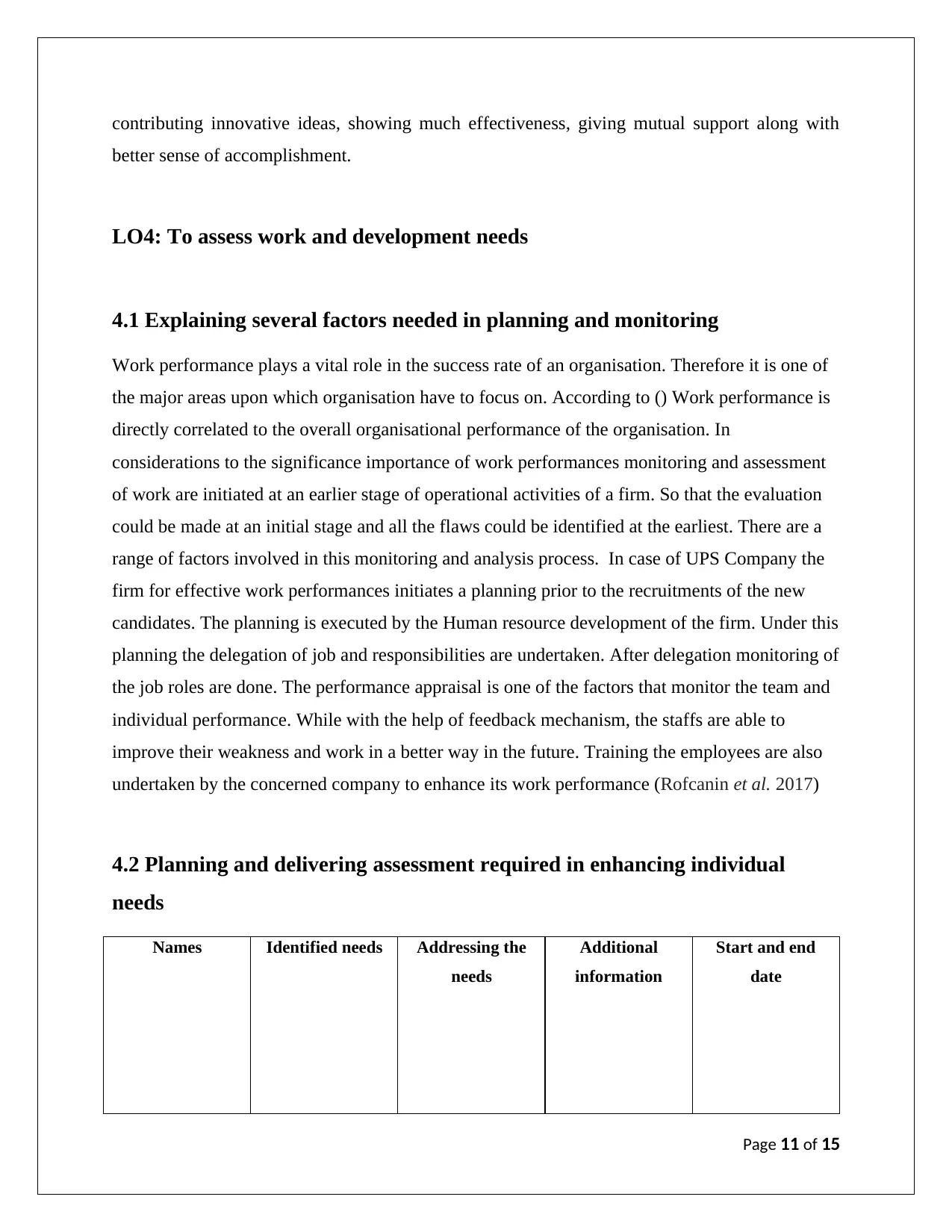
contributing innovative ideas, showing much effectiveness, giving mutual support along with
better sense of accomplishment.
LO4: To assess work and development needs
4.1 Explaining several factors needed in planning and monitoring
Work performance plays a vital role in the success rate of an organisation. Therefore it is one of
the major areas upon which organisation have to focus on. According to () Work performance is
directly correlated to the overall organisational performance of the organisation. In
considerations to the significance importance of work performances monitoring and assessment
of work are initiated at an earlier stage of operational activities of a firm. So that the evaluation
could be made at an initial stage and all the flaws could be identified at the earliest. There are a
range of factors involved in this monitoring and analysis process. In case of UPS Company the
firm for effective work performances initiates a planning prior to the recruitments of the new
candidates. The planning is executed by the Human resource development of the firm. Under this
planning the delegation of job and responsibilities are undertaken. After delegation monitoring of
the job roles are done. The performance appraisal is one of the factors that monitor the team and
individual performance. While with the help of feedback mechanism, the staffs are able to
improve their weakness and work in a better way in the future. Training the employees are also
undertaken by the concerned company to enhance its work performance (Rofcanin et al. 2017)
4.2 Planning and delivering assessment required in enhancing individual
needs
Names Identified needs Addressing the
needs
Additional
information
Start and end
date
Page 11 of 15
better sense of accomplishment.
LO4: To assess work and development needs
4.1 Explaining several factors needed in planning and monitoring
Work performance plays a vital role in the success rate of an organisation. Therefore it is one of
the major areas upon which organisation have to focus on. According to () Work performance is
directly correlated to the overall organisational performance of the organisation. In
considerations to the significance importance of work performances monitoring and assessment
of work are initiated at an earlier stage of operational activities of a firm. So that the evaluation
could be made at an initial stage and all the flaws could be identified at the earliest. There are a
range of factors involved in this monitoring and analysis process. In case of UPS Company the
firm for effective work performances initiates a planning prior to the recruitments of the new
candidates. The planning is executed by the Human resource development of the firm. Under this
planning the delegation of job and responsibilities are undertaken. After delegation monitoring of
the job roles are done. The performance appraisal is one of the factors that monitor the team and
individual performance. While with the help of feedback mechanism, the staffs are able to
improve their weakness and work in a better way in the future. Training the employees are also
undertaken by the concerned company to enhance its work performance (Rofcanin et al. 2017)
4.2 Planning and delivering assessment required in enhancing individual
needs
Names Identified needs Addressing the
needs
Additional
information
Start and end
date
Page 11 of 15
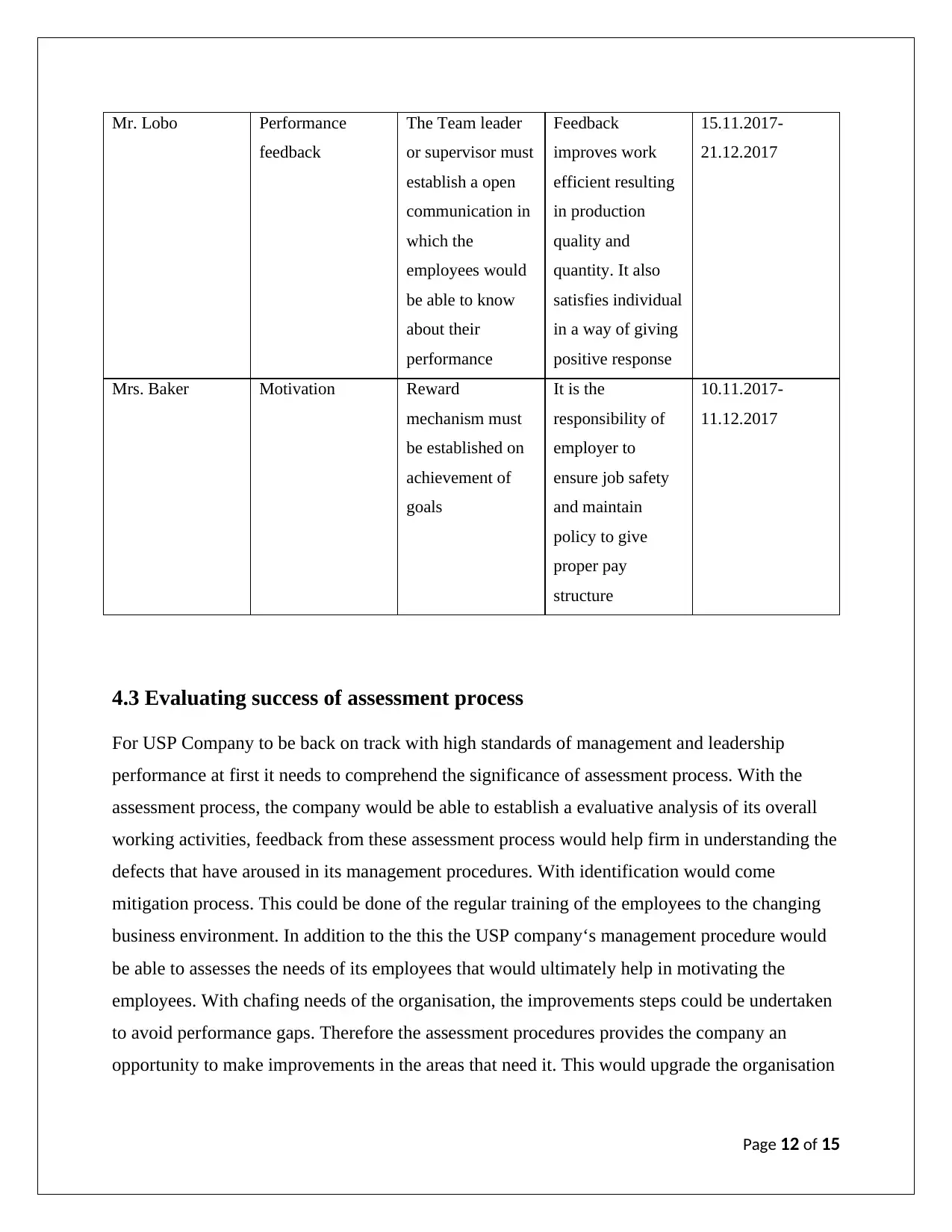
Mr. Lobo Performance
feedback
The Team leader
or supervisor must
establish a open
communication in
which the
employees would
be able to know
about their
performance
Feedback
improves work
efficient resulting
in production
quality and
quantity. It also
satisfies individual
in a way of giving
positive response
15.11.2017-
21.12.2017
Mrs. Baker Motivation Reward
mechanism must
be established on
achievement of
goals
It is the
responsibility of
employer to
ensure job safety
and maintain
policy to give
proper pay
structure
10.11.2017-
11.12.2017
4.3 Evaluating success of assessment process
For USP Company to be back on track with high standards of management and leadership
performance at first it needs to comprehend the significance of assessment process. With the
assessment process, the company would be able to establish a evaluative analysis of its overall
working activities, feedback from these assessment process would help firm in understanding the
defects that have aroused in its management procedures. With identification would come
mitigation process. This could be done of the regular training of the employees to the changing
business environment. In addition to the this the USP company‘s management procedure would
be able to assesses the needs of its employees that would ultimately help in motivating the
employees. With chafing needs of the organisation, the improvements steps could be undertaken
to avoid performance gaps. Therefore the assessment procedures provides the company an
opportunity to make improvements in the areas that need it. This would upgrade the organisation
Page 12 of 15
feedback
The Team leader
or supervisor must
establish a open
communication in
which the
employees would
be able to know
about their
performance
Feedback
improves work
efficient resulting
in production
quality and
quantity. It also
satisfies individual
in a way of giving
positive response
15.11.2017-
21.12.2017
Mrs. Baker Motivation Reward
mechanism must
be established on
achievement of
goals
It is the
responsibility of
employer to
ensure job safety
and maintain
policy to give
proper pay
structure
10.11.2017-
11.12.2017
4.3 Evaluating success of assessment process
For USP Company to be back on track with high standards of management and leadership
performance at first it needs to comprehend the significance of assessment process. With the
assessment process, the company would be able to establish a evaluative analysis of its overall
working activities, feedback from these assessment process would help firm in understanding the
defects that have aroused in its management procedures. With identification would come
mitigation process. This could be done of the regular training of the employees to the changing
business environment. In addition to the this the USP company‘s management procedure would
be able to assesses the needs of its employees that would ultimately help in motivating the
employees. With chafing needs of the organisation, the improvements steps could be undertaken
to avoid performance gaps. Therefore the assessment procedures provides the company an
opportunity to make improvements in the areas that need it. This would upgrade the organisation
Page 12 of 15
⊘ This is a preview!⊘
Do you want full access?
Subscribe today to unlock all pages.

Trusted by 1+ million students worldwide
1 out of 15
Related Documents
Your All-in-One AI-Powered Toolkit for Academic Success.
+13062052269
info@desklib.com
Available 24*7 on WhatsApp / Email
![[object Object]](/_next/static/media/star-bottom.7253800d.svg)
Unlock your academic potential
Copyright © 2020–2025 A2Z Services. All Rights Reserved. Developed and managed by ZUCOL.





